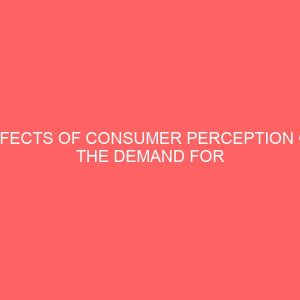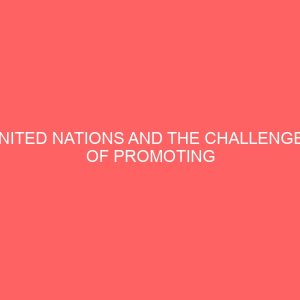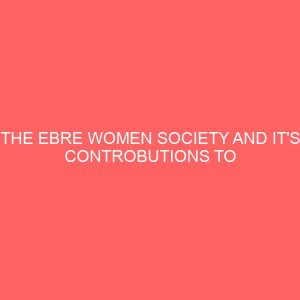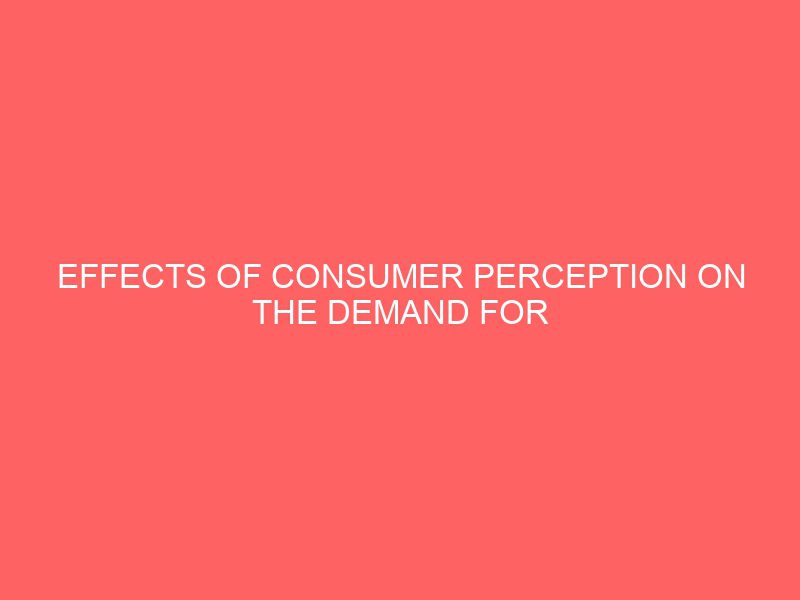Description
CHAPTER ONE
INTRODUCTION
1.0 BACKGROUND TO THE STUDY:
Life insurance companies are financial intermediaries that bring together the surplus spending unit (insured) and the deficit spending unit (insurer) for the purpose of the insurer protecting the financial interest of the beneficiary in the event of the demise of the insured (Impavido and Musalem, 2000). In this process life insurance companies act as a vehicle for the mobilization of savings for long term investment purpose, leading to economic growth and development. Through financial intermediation, life insurance product has become a key source of long term finance, encouraging the development of the global capital markets (Catalan et al., 2000; Impavido and Musalem, 2000).
Insurance itself is a risk transfer mechanism whereby the individual or the business enterprise can shift some of the uncertainties of life on the shoulder of another (liquat, 2006).
Life insurance is a policy that replaces a lost stream of income that results from the death of an individual (Todd, 2004). Life insurance is undertaken to provide protection to the insured’s family, creditors, or others against the loss of earning capability of the insured in the event of his death or serious injury. According to Oke et al (2010) life insurance is a protection of an economic value of an asset.
Laying affirmation to the inevitability of the occurrence of death someday Liquat (2006) submits that, there is a general agreement as to the fact that risk is present in all human endeavours as there is uncertainty as to what will be the likely outcome about a person’s action, and there is no certainty however about the exact time, date, year or place when such event like death will occur to anyone.
Hence, for the human life, there is uncertainty about when death will occur, but there is the certainty that death must occur. The need therefore to provide for the needs of one’s dependants after life necessitate the need for life assurance. In addition, life assurance the endowment type may be taken out to provide for specific expenditure in the future and the categories for which life assurance will provide for include the risks of premature death, death, longevity, disability and sickness (Oyetayo, 2006; Vaughan and Vaughan, 2002).
Understanding the consumer’s perception and attitude towards insurance and creating a demand for life insurance is essential in facilitating the success of insurance services. Perception is the method by which organism deduce and categorize sensation to fabricate a significant experience of the world (Razak and Kasim, 2014).
Baker (2003) assert that perception can also be described as one’s (consumer’s) ultimate experience of the world and typically involves further processing of sensory input. In practice, sensation and perception are virtually impossible to separate, because they are part of one (consumer) continuous process. Thus, perception in humans describes the process whereby sensory stimulation is translated into organized experience or percept. Other than that, the processes of perception routinely alter what humans see (Razak and Kasim, 2014).
When people view something with a preconceived concept about it, they tend to take those concepts and see them whether or not they are there. This problem stems from the fact that humans are unable to understand new information, without the inherent bias of their previous knowledge (Jessica, Devin and Brandy, 2009). A person’s knowledge creates his or her reality as much as the truth, because the human mind can only contemplate that to which it has been exposed. When objects are viewed without understanding, the mind will try to reach for something that it already recognizes, in order to process what it is viewing (Razak and Kasim, 2014).
In other word, perception on the workability and effectiveness of life insurance product may be an important factor that may affect how the policies will be demanded by prospective customers. Hence, this research study will examine the “effects of consumer perception on the demand for life insurance products with a special reference to staff of Lagos State University, Ojo.
1.1 STATEMENT OF THE PROBLEM:
Demand for any product may be affected by a number of factors depending on the nature of the product and the considered utility derivable from it. And for a product like life assurance, the demand for insurance arises from the satisfaction that a consumer gains from the increase in financial security achieved by transferring the risk of loss to an insurer such factors as the country’s level of development, in terms of standard of living and availability of medical infrastructures, life expectancy, level of dependency of the old on their children and government as well as the number of educated people in that country will be important influences on the demand for life insurance product.
Researches linking consumers’ perception with demand for life insurance products in developing countries with Nigeria inclusive have shown that insurance services seem not to have been so accepted enthusiastically in developing countries. The abysmal level of consumers’ perception and ultimate demand for life insurance products in developing economies has attracted relative interests among researchers and practitioners alike.
Risk has been identified as a central fact of life in most cities in Nigeria. For example, Omar (2005) assesses consumers’ perception towards life insurance patronage in Nigeria and found out that there is lack of trust and confidence in the insurance companies. Other major reason for this attitude is lack of knowledge about life insurance product, owing to lack of marketing communication strategy that is based on re-orientating and informing the consumers of the benefits inherent in life insurance so as to reinforce the purchasing decision. Some of the problems associated with this perceptual error have been one of improper marketing strategy.
The role of culture in Nigeria is all pervasive that demand for life insurance is grossly affected to the extent that it defines consumers risk aversion. Now, religion is another drawback since it provides an insight into the individual’s behaviour; and understanding religion is an important component of understanding a nation’s unique culture. Religion historically has provided a strong source of cultural opposition to life insurance as many religious people believe that a reliance on life insurance results from a distrust of God’s protecting care. Until the nineteenth century, European nations condemned and banned life insurance on religious grounds. Even until now religious antagonism to life insurance still remains in several Islamic countries.
According to Ifejionu and Emmanuel (2013) there are four main attitudes which religious opinion may adopt towards social institutions and economic relations and these are:
§ Standing on one side in ascetic aloofness
§ Taking for granted and ignoring them
§ Throwing itself into an agitation for some particular reform
§ Asking for amendment to what is on offer.
The Lagos State University is currently having a life insurance scheme that provides cover for its teaching and non teaching staff. But the effectiveness of this policy has often led to some serious debate among the different stakeholders calling for its improvement. Their bitterness is the fact that families and relatives of the deceased go through struggles and prolonged waiting before receiving the entitlement of those who had meritorious served the institution. For example, in the recent time of the twenty (20) staff members of the Lagos state university who died in the past five (5) years, families of two (2) staffs are yet to be paid.
It is against this backdrop that the researcher is inspired to assess the effect of consumer perception on the demand for life insurance products with a special reference to staff of Lagos State University, Ojo.
1.2 OBJECTIVES OF THE STUDY:
The major objective of this study is to determine the effect of consumer perception on the demand for life insurance products. While other specific objectives include;
1.To examine the effect of consumer perception on the demand for life insurance products in Nigeria.
2.To assess the impact of cultural cleavages on demand for life insurance policy.
3.To investigate the effect of religious belief on demand for life insurance products.
4.To enunciate the importance of life insurance policy.
5.To find out the link between standard of living and demand for life insurance products.
To investigate the factors that may cause lack of confidence by prospective assured/customer.
7.To find out if there is a relationship between insurance awareness and demand for life insurance products.
8.To examine the role marketing might play in the perception of the prospective assured/customer.
9.To provide plausible recommendation on how to improve consumers perception towards life insurance products in Nigeria.
1.3 RESEARCH QUESTIONS:
The undertaking of this research project will beam a searchlight on the following research questions;
1.Does consumer perception have effect on the demand for life insurance products in Nigeria?
2.What is the effect of cultural cleavages on demand for life insurance policy?
3.What is the relationship between religious belief and demand for life insurance products?
4.What is the importance of life insurance policy?
5.Is there any link between standard of living and demand for life insurance products?
6.What are the factors that may cause lack of confidence by prospective customers?
7.Is there any relationship between insurance awareness and demand for insurance?
8.What are the roles of marketing in the perception of prospective customers?
1.4 RESEARCH HYPOTHESES:
Hypothesis One:
Ho: There is no significant relationship between insurance awareness and emand for life insurance products in Nigeria.
Hi: There is a significant relationship between insurance awareness and demand for life insurance products in Nigeria.
Hypothesis Two:
Ho: Cultural cleavages do not have any effect on demand for life insurance policy.
Hi: Cultural cleavages have an effect on demand for life insurance policy.
Hypothesis Three:
Ho: There is no significant relationship between religious beliefs and demand for life insurance products.
Hi: There is a significant relationship between religious beliefs and demand for life insurance products.







